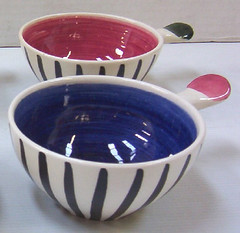
It has taken me a while to sort out the various members of the Boyd family and their potting activities, even with the help of Geoff Ford’s Encyclopaedia of Australian Potter’s Marks. I’ll start with Merric Boyd (1888-1959), known as the father of Australian art pottery because of his tenuous forms inspired by Australian flora and fauna. He and his wife Doris (1883-1960) had a pottery at Murrumbeena where they led a sometimes precarious existence selling pottery to the Melbourne market. Merric began potting in 1912 and continued to make pots until his death in 1959.
Their five children, Lucy (1916-2009), Arthur (1920-1999), Guy (1923-1988), David (1924-2011) and Mary (1926-) all made pottery at some stage in their lives, as did Lucy’s husband Hatton Beck (1901-1994) , Arthur’s wife Yvonne (1920-2013), David’s wife Hermia (1931-2000) and Mary’s first husband John Perceval (1923-2000). Lucy’s son Robert Beck (1942-) and his wife Margot are also potters, as is Guy’s daughter Derry (1957-).

Robert and Margot Beck made this cheese dish with domed cover given to me by colleagues when I left work to go back to university in 1979. It illustrates the extent to which painting and pottery was closely intertwined in the Boyd family. Doris was a talented painter and decorated some of her husband’s pots. Their children learnt to make and decorate pottery at their parents’ knees and were able to use this skill as a way of making a living while they explored other areas of interest such as painting and sculpture. They married other artists and drew them into the family tradition. The second-world war interrupted their lives but also led them to new artistic associations.
Merric’s father Arthur Merric Boyd (1862-1940) was a painter, not a potter, but his name lives on in the Arthur Merric Boyd (AMB) Pottery set up by his grandson Arthur, John Perceval and Peter Herbst at Murrumbeena in 1944. (Actually, they bought Hatton Beck’s pottery when the Becks moved to Brisbane.) The pair of ramekins illustrated at the head of this entry were made at this pottery and hand painted by John Perceval. Arthur left Australia for England in 1958 and went on to become one of Australia’s most significant painters, but pieces with various AMB marks continued to be made until 1962.
Similarly, Merric’s younger brother Martin (1893-1972) was a writer not a potter, but his name lives on in the Sydney-based Martin Boyd Pottery set up by Guy with partners Norma and Leonard Flegg in 1946. Guy was training as a sculptor at the East Sydney Technical College (ESTC) after the war and needed an interim source of income. He returned to Melbourne in 1951 but the Fleggs continued to operate the Martin Boyd Pottery as a successful venture until overseas imports put it out of business in 1963 (Dorothy Johnston, The Peoples’ Potteries, pp. 87-91).
Ford (p. 43) records the year of Guy’s return to Melbourne as 1955. In fact, he transferred his interest in the pottery to Leonard’s brother Ronald in 1951. On his return to Melbourne, he set up a new pottery, the Guy Boyd Pottery, in 1952. He and his wife operated this until 1964, when he sold it to devote himself full-time to sculpture (Guide to the papers of Guy and Phyllis Boyd, MS 7551, National Library of Australia).
Guy’s brother David worked with him as a thrower in Sydney in the start-up post-war years. This is where he met Hermia, an art student at ESTC experimenting with decoration at the pottery in her spare time. They lived and worked in Australia, England and France before closing their last pottery in Murrumbeena in 1968 to concentrate on other interests – David on painting and Hermia on etchng and sculpture (John Vader, The Pottery of David and Hermia Boyd, Matthews/Hutchinson, 1977).

To my 1970s-trained eye, David and Hermia Boyd’s work is often quirky and unusual. Their style owes nothing to the Leach Hamada tradition. They used a range of techniques based on white earthenware or terracotta clay (as in this example), metallic lustres and washes, sgraffito drawing through tin or black glaze and underglaze or overglaze decoration. They were influenced by French provincial pottery and medieval imagery.
Their work was marketed as art pottery through exhibitions rather than stores. In 1960 they were guest exhibitors at the Potters’ Cottage in Warrandyte where it was reported that great interest was shown in the new techniques they had developed during their overseas travels and prices ranged as high as fifty guineas (Vader, p. 132) .
For collectors, enough Boyd pottery is listed on eBay to merit its own category under ‘Australian Pottery’. Here even small pieces of Merric’s work are priced outside our range. Arthur and Hermia Boyd also attract a lot of interest, as do the larger AMB pieces painted by John Perceval or Neil Douglas.

The majority of eBay listings are from the Martin Boyd Pottery which has its own strong following. Ramekins abound and no wonder because it was the pottery’s most popular production line and nearly a million were made (Johnston, p.90). Ramekins were also a mainstay of the Guy Boyd and AMB Potteries. This form was simple to throw and decorate. The handle also lends aplomb, particularly when incorporated seamlessly into the form and decoration. We haven’t been able to resist setting up a ramekin collecting sideline and now have quite a few excellent examples.






